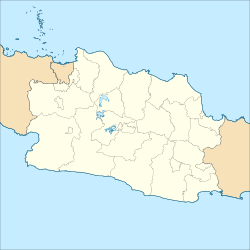 | |
| UTC time | 2009-09-02 07:55:01 |
|---|---|
| ISC event | 15161670 |
| USGS-ANSS | ComCat |
| Local date | 2 September 2009 |
| Local time | 14:55:01 WIB |
| Magnitude | 7.0 Mw [1] |
| Depth | 49 km (30 mi) |
| Epicenter | 7°46′55″S107°17′49″E / 7.782°S 107.297°E |
| Areas affected | Indonesia |
| Max. intensity | MMI VII (Very strong) |
| Tsunami | 20 cm |
| Casualties | 81 dead 1,297 injured 210,000 displaced |
An earthquake occurred on September 2, 2009, at 14:55:01 local time in West Java, Indonesia. [1] The magnitude 7.0 earthquake killed at least 81 people, injured over 1,297, and displaced over 210,000 (including more than 140,000 in Tasikmalaya regency). [2] [3] The quake was felt in the capital Jakarta, although damage there was minimal, and it was Indonesia's deadliest earthquake since the 2006 Pangandaran earthquake and tsunami. [4]

